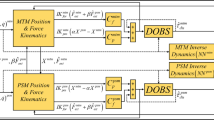Abstract
Haptic rendering has been long considered as the process of estimating the force that stems from the interaction of a user and an object. Even if this approach follows the principles of natural haptic interaction, it places severe limitations in processing haptic media. This paper presents an information theoretic framework that aims to provide a new view of haptic rendering that can accommodate for open-loop synthetic haptic media, where interaction-based rendering is a special case. As a result, using the proposed information-theoretic approach, the haptic signal can be precomputed as a force field, stored and then filtered by taking into account device and perceptual capabilities of the receiver in order to lower the required bandwidth of the resulting stream, thus opening new possibilities for the representation and processing of haptic media.









Similar content being viewed by others
Notes
Typical quantizers are usually optimized by selecting decision boundaries and output levels in order to minimize the distortion (e.g., mean square error) between the input real number and its quantized representation.
References
Borst C (2005) Predictive coding for efficient host-device communication in a pneumatic force-feedback display. In: Proceedings first joint eurohaptics conference symposium. Haptic interfaces for virtual environ. Teleoperator system, pisa, Italy pp 596–599
Cha J, Ho YS, Kim Y, Ryu J (2009) A framework for haptic broadcasting. IEEE Multimedia 16(3):16–27
El-Saddik A, Orozco M, Asfaw Y, Shirmohammadi S, Adler A (2007) A novel biometric system for identification and verification of haptic users. IEEE Trans Instrum Meas 56(3):895–906. doi:10.1109/TIM.2006.887174
Guruswamy V, Lang J, Lee WS (2011) Iir filter models of haptic vibration textures. IEEE Trans Instrum Meas 60(1):93–103. doi:10.1109/TIM.2010.2065751
Hamam A, Saddik A (2013) Toward a mathematical model for quality of experience evaluation of haptic applications. IEEE Trans Instrum Meas PP(99):1–1. doi:10.1109/TIM.2013.2272859
Hayward V (2011) Is there a plenhaptic function. Phil Trans R Soc B 366:3115–3122
Hinterseer P, Hirche S, Chaudhuri S, Steinbach E, Buss M (2008) Perception-based data reduction and transmission of haptic data in telepresence and teleaction systems. IEEE Trans Signal Process 56(2):588–597
Hirche S, Bauer A, Buss M (2005) Transparency of haptic telepresence systems with constant time delay. In: Proceeding IEEE International Conference Control Appl., Toronto, Canada pp. 328–333
Hossain S, Rahman A, El-Saddik A (2011) Measurements of multimodal approach to haptic interaction in second life interpersonal communication system. IEEE Trans Instrum Meas 60(11):3547–3558. doi:10.1109/TIM.2011.2161148
Jianxiong X, Owens A, Torralba A (2013). SUN3D: A Database of Big Spaces Reconstructed Using SfM and Object Labels. In: 2013 IEEE International Conference on Computer Vision (ICCV), pp 1625–1632
Kim M, Lee S, Choi S (2014) Saliency-driven real-time video-to-tactile translation. IEEE Transactions on Haptics 7(3):394–404
Kostopoulos K, Moustakas K, Tzovaras D, Nikolakis G, Thillou C, Gosselin B (2007) Haptic access to conventional 2d maps for the visually impaired. Springer International Journal on Multimodal User Interfaces 1(2):13–19
Kron A, Schmidt G, Petzold B, Zh MF, Hinterseer P, Steinbach E (2004) Disposal of explosive ordnances by use of a bimanual haptic telepresence system. In: Proceedings IEEE International Conference Robot. Autom., New Orleans, LA pp 1968–1973
Kuschel M, Cremer P, Buss M (2009) Passive haptic data-compression methods with perceptual coding for bilateral presence systems. IEEE Trans Syst Man Cybern Syst Hum 39(6):1142– 1151
Laycock S, Day A (2007) A survey of haptic rendering techniques. Comput Graphics Forum 26(1):50–65
Lin M, Otaduy M (2008) Haptic rendering: foundations, algorithms and applications. p A.K.Peters publishing
Lloyd AS (2006) Least squares quantization in PCM. IEEE Trans Inf Theor 28(2):129–137. doi:10.1109/TIT.1982.1056489
Moustakas K (2013) Haptic media from an information theoretic perspective. In: IEEE International symposium on haptic, audiovisual environments and games, IEEE HAVE 2013, Istanbul
Moustakas K, Nikolakis G, Tzovaras D, Strintzis M (2005) Stereoscopic video generation based on efficient layered structure and motion estimation from a monoscopic image sequence. IEEE Trans Circuits Syst Video Technol 15(8):1065–1073
Moustakas K, Tzovaras D, Strintzis M (2007) Sq-map: Efficient layered collision detection and haptic rendering. IEEE Trans Vis Comput Graph 13(1):80–93
Moustakas K, Nikolakis G, Kostopoulos K, Tzovaras D, Strintzis M (2007) Haptic rendering of visual data for the visually impaired. IEEE Multimedia 14(1):62–72
Nikolakis G, Koutsonanos D, Daras P, Moustakas K, Tzovaras D, Strintzis M (2006) Haptic interaction in medical virtual environments. In: Wiley Encyclopedia of Biomedical Engineering, 6- Volume Set, Metin Akay (Editor) ISBN : 0-471-24967-X
Ortega A, Liu Y (2002) Lossy compression of haptic data. In: Touch in virtual environments: Haptics and the design of interactive systems. Englewood cliffs, NJ: Prentice-hall, ch. 6, pp 119–136
Ou E, Basdogan C (p 2002) Network considerations for a dynamic shared haptic environment. In: Proceedings Nat. Conf. Undergrad. Res Whitewater, WI
Robles-De-La-Torre G (2006) The importance of the sense of touch in virtual and real environments. IEEE Multimedia 13(3):24–30
Saddik E (2007) The potential of haptics technologies. IEEE Instrum Meas Mag 10(1):10–17
Sakr N, Georganas ND, Zhao J (2011) Human perception-based data reduction for haptic communication in six-dof telepresence systems. IEEE Trans Instrum Meas 60(11):3534–3546. doi:10.1109/TIM.2011.2161144
Shen X, Zhou J, El-Saddik A, Georganas ND (2004) Architecture and evaluation of tele-haptic environments. In: Eighth IEEE international symposium on distributed simulation and real-time applications, DS-RT, pp 53–60
Sakr N, Zhou J, Georganas ND, Zhao J (2009) Prediction-based haptic data reduction and transmission in telementoring systems. IEEE Trans Instrum Meas 58(5):1727–1736. doi:10.1109/TIM.2008.2009146
Srinivasan M, Basdogan C (1997) Haptics in virtual environments: taxonomy, research status and challenges. Comput Graph:393–404
Ternes D, MacLean K (2008) Designing large sets of haptic icons with rhythm. Springer LNCS Haptics: Perception Devices and Scenarios 5024:199–208
Vu MH, Na UJ (2011) A new 6-dof haptic device for teleoperation of 6-dof serial robots. IEEE Trans Instrum Meas 60(11):3510–3523. doi:10.1109/TIM.2011.2164285
Wang H, Liu X (2011) Haptic interaction for mobile assistive robots. IEEE Trans Instrum Meas 60(11):3501–3509. doi:10.1109/TIM.2011.2161141
Author information
Authors and Affiliations
Corresponding author
Rights and permissions
About this article
Cite this article
Moustakas, K., Lalos, A.S. An information-theoretic treatment of passive haptic media. Multimed Tools Appl 76, 6189–6208 (2017). https://doi.org/10.1007/s11042-016-3281-x
Received:
Revised:
Accepted:
Published:
Issue Date:
DOI: https://doi.org/10.1007/s11042-016-3281-x




